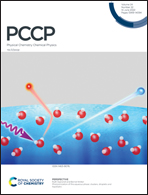Combination of multiple methods and views for recognition, transportation, and structure-guided modification of lysine-specific demethylase phenylcyclopropylamine inhibitor†
Abstract
Lysine-Specific Demethylase 1 (LSD1) is a typical histone-specific demethylase, which plays an important role in protein methylation modification. It is a member of the amine oxidase family (MAO) that specifically removes methyl groups from monomethylated H3K4, dimethylated H3K4 and H3K9 sites associated with tumorigenesis. Phenylcyclopropylamine derivatives are a class of specific LSD1 inhibitors, drawing attention due to their high efficiency. Here, extensive molecular dynamics (MD) simulations are combined with a three-dimensional quantitative structure–activity relationship (3D-QSAR) in order to design a new phenylcyclopropylamine inhibitor from multiple perspectives. In a ligand-oriented point of view, a 3D-QSAR model with comparative molecular field analysis (CoMFA) and comparative molecular similarity index analysis (CoMSIA) can be built based on the 55 phenylcyclopropylamine compounds targeting LSD1 obtained experimentally. The aromatic and piperazine rings are identified as the potential key groups regulating the activity of the compounds. In an interaction-oriented view, the representative compound is defined with the highest inhibitory efficiency. The binding and delivery mechanism and conformational dependence of activity, including channel and dynamic properties, are studied using RAMD and umbrella sampling technologies. The direct hydrogen bond and conjugated interactions are identified as a major driving force in this procedure. The dominant region of the phenylcyclopropylamine influences the free energy and detects the key residues in recognition and delivery. On the basis of both the ligand and interaction, a series of new inhibitor structures were designed, and two of them showed better efficiency. In order to select the inhibitor with a longer residence time, a comparison is conducted between the designed inhibitors and the experimentally obtained inhibitor from the perspective of static binding and dynamic delivery properties. This work creates new guidance for the phenylcyclopropylamine inhibitor design of LDS1 by combining the ligand and receptor, considering both static and dynamic properties. This scheme could be applied in other inhibitor design systems.



 Please wait while we load your content...
Please wait while we load your content...